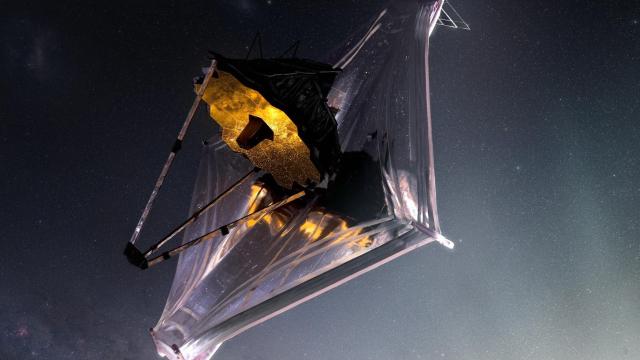NASA said today that one of the Webb Space Telescope’s primary mirror segments was hit by a micrometeoroid, a small asteroid fragment, between May 23 and May 25. Initial assessments of the telescope found that the spacecraft was still performing exceptionally well, though the effects of the impact were noticeable in recent data readouts.
Micrometeoroids are extremely small (dust-sized), fast-moving space debris. They’re a regular part of a hostile space environment that will bombard the Webb telescope throughout its years in operation.
“With Webb’s mirrors exposed to space, we expected that occasional micrometeoroid impacts would gracefully degrade telescope performance over time,” said Lee Feinberg, Webb optical telescope element manager at NASA, in an agency release. “Since launch, we have had four smaller measurable micrometeoroid strikes that were consistent with expectations and this one more recently that is larger than our degradation predictions assumed.”
Webb arrived at L2, its observation point in space, in late January. L2 is a million miles from Earth, but that doesn’t mean the telescope is just floating in empty space. On the contrary, the telescope sits in a dynamic part of the solar system that comes with a bounty of hostile space weather phenomena. Besides micrometeoroids, there are cosmic rays, charged solar winds, and ultraviolet radiation, all of which can damage spacecraft.
Thankfully, Paul Geithner, a technical deputy project manager at NASA, said in the release that “We designed and built Webb with performance margin – optical, thermal, electrical, mechanical – to ensure it can perform its ambitious science mission even after many years in space.”
Webb’s mirrors are perhaps the most essential component of the $US10 ($14) billion spacecraft. The mirrors are what focus the light from the cosmos, allowing Webb to image everything from nearby exoplanets to the oldest sources of light in the universe. After the telescope arrived at L2, the mirror went through a lengthy alignment period; in early May, Webb scientists said that the mirrors’ alignment was perfect.
When Webb was being built, its engineers designed the mirrors to handle micrometeoroids like the one that recently impacted one of the segments. The telescope can adjust its mirror positions to correct for impacts from micrometeoroids, minimising the effects such collisions can have on the telescope’s imaging.
Larger events like meteor showers are a bigger bother, but the telescope can be oriented away from such events to protect its optical equipment, the NASA release stated. The team — and therefore, Webb — appears to be well prepared for the conditions of space at L2.
The telescope’s first full-colour images are expected on July 12; though NASA has not announced what Webb will be imaging, we know that the images will capture one of the telescope’s primary science targets. A couple pings off the ol’ mirrors by some dusty micrometeoroids won’t stop the landmark telescope from beginning its scientific operations this summer.
More: Latest Image Shows the Awesome Power of the Webb Space Telescope
